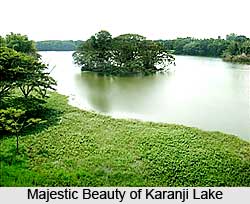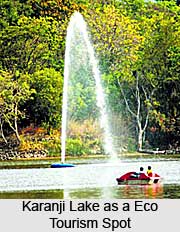 Karanji Lake is located in the city of Mysore in the Indian state of Karnataka. The lake is surrounded by Nature Park that consists of a butterfly park and a walk-through aviary. This aviary happens to be the biggest "walk through aviary" in India. There is also a museum - the Regional Museum of Natural History that is situated on the banks of this lake. The total area of Karanji Lake is 90 hectares. While the water-spread area is about 55 hectares, the foreshore area calculates about 35 hectares. Karanji Lake is owned and maintained by the Mysore Zoo Authority.
Karanji Lake is located in the city of Mysore in the Indian state of Karnataka. The lake is surrounded by Nature Park that consists of a butterfly park and a walk-through aviary. This aviary happens to be the biggest "walk through aviary" in India. There is also a museum - the Regional Museum of Natural History that is situated on the banks of this lake. The total area of Karanji Lake is 90 hectares. While the water-spread area is about 55 hectares, the foreshore area calculates about 35 hectares. Karanji Lake is owned and maintained by the Mysore Zoo Authority.
History of Karanji Lake
The Karanji Lake was one of the popular haunts of migratory birds like the egrets and herons. But the entire lake started getting polluted when sewage from nearby neighbouring areas were let into the lake. This pollution actually led to the destruction of aquatic life in the lake and with food source getting depleted, the migratory birds started to avoid lake.
To prevent damage and destruction of this lake and to modernize it, assistance was sought from the Asian Development Bank (ADB), Karnataka Urban Infrastructure Development Finance Corporation (KUIDFC) and Zoo Authority of Karnataka (ZAK). These three organizations actually came together and undertook the work of restoration activities of this lake.
 Aviary at Karanji Lake
Aviary at Karanji Lake
The Aviary that was set up on the shore of lake has a length of 60 m and height of 20 m and width of 40 m making it biggest walk through aviary in India. It consists of an artificial water fall and two small water bodies. The water from the lake is pumped into the aviary in the form of stream while the used water is also discharged into the lake. The aviary houses around 40 to 50 birds of 17 species. Hornbills, peacocks, white-peacocks, turkeys and black swans are some of the birds found in this aviary. This aviary was temporarily closed in the year 2006 to prevent the break-out of bird flu.
Butterfly Park at Karanji Lake
Butterfly Park has been constructed on the tiny island within the Karanji Lake. It has about 45 species of butterflies. There were special botanists specified to select and breed special type of butterflies.
Birds of Karanji Lake
Some of the ordinary migratory birds found in the region are Grey Pelican, Painted Stork, Ibis, Cormorant, Egret, etc. that nest on trees in the island present in lake. Recent studies on birds have indicated 147 species.
Herons, Asian open bill storks, Egrets, Red wattle lapwing, Sandpipers, Rose ringed parakeet, Black Drongo, Brown Shrike, Red-whiskered bulbul, Booted warbler, Sunbird and Greenish Warbler are some of the other species of birds found here















